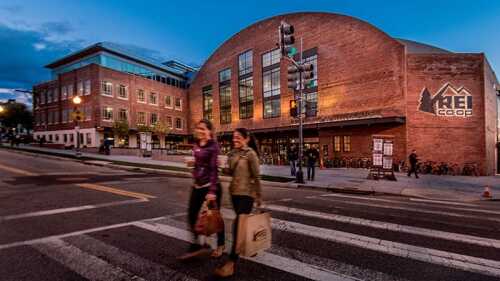In the Englewood neighborhood on the South Side of Chicago, 42 percent of households currently live below the federal poverty line. The unemployment rate of 21 percent is almost twice the city’s average. An aerial view of the community shows a startling number of vacant lots, and a walk through it would offer scant retail.
In nearly every way — crime rates included — Englewood does not fit the standard definition of a Whole Foods market. And yet the high-end grocer announced this week plans to open a store there in 2016 on the northwest corner of this sparse intersection:
The proposal is not entirely novel. Whole Foods moved into the unlikely market of Detroit earlier this year just as many companies and residents were moving out. Some critics viewed that midtown store as the ultimate marker of gentrification in a city awkwardly occupied by both the down-and-out and the urban adventurer. In Englewood, however, there are no gentrifiers in sight. This store is actually targeting a kind of community that the brand has never served before.
The idea raises some fascinating questions: Exactly how will this work? Can a regular Whole Foods habit really be affordable to one of the lowest-income communities in the city? How much will Whole Foods have to modify its typical business model to work here? Will it even be profitable for them to try to do that? And a question surely on Whole Foods’ mind: Can a project like this begin to dislodge the widely held perception that Whole Foods is a grocery store for people who obsessively check natural ingredient lists but not price tags?
The project will pit two very savvy groups on opposite sides of the cash register: Whole Foods certainly knows how to make money. And no one knows the value of a dollar quite like the poor.
The city spent what Mayor Rahm Emanuel described this week as 14 months wooing the company to move in to anchor what it hopes will ultimately become a 13-acre development (the Chicago Tribune tartly noted that the announcement came this week just after the newspaper ran a story critical of the mayor’s unfulfilled promises to eradicate the city’s food deserts). The project looks likely to receive some tax increment financing from the city.
But back to the biggest question: Seriously, will this Whole Foods be affordable? How’s that possible?
“They believe it’s a myth that to eat healthy has to be very expensive,” says Tom Alexander, a deputy director of communications in Emanuel’s office. The company has already suggested a few ways it may tweak its brand at this location, by for instance more heavily relying on its in-house 365 line of products, and by selling more food in bulk that will allow the store to make up in volume what it loses in lower price points. Alexander says that the store also plans to price fruits and vegetables individually, instead of by the pound, to help shoppers ensure they understand exactly what they’re paying.
Whole Foods is promising extensive shopper and cooking education (one of the benefits of that otherwise empty intersection is that a community college is located across the street with a culinary institute). And the store is promising over the next three years to talk with the community about what it wants.
“That being said,” Alexander says, “it is a Whole Foods market, it is a legitimate store, it is a for-profit store. And so they are focused on pricing their food so they can get business and be successful.”
Popular perceptions of food deserts run both directions between communities that go unserved and the stores that don’t serve them. One stereotype may say that healthy food can’t be affordable. But another says that neighborhoods like these can’t be profitable to major grocery chains. Why else would the city — any city — have to exert so much effort coaxing full-service grocers into markets where none already exist?
It will be very interesting to see what happens next in Englewood. None of the Whole Foods I have ever been in — heavy on the $15 floral arrangements and cured meats — will work there. Maybe they spend less money offering free samples of fancy cheese? Maybe the prepared food section emphasizes no-frills dinners over sushi rolls? If Whole Foods does that, some people may equally criticize it for offering a substandard imitation of its flagship stores. But if big-box Target can wedge itself into urban neighborhoods, maybe Whole Foods can do the same with an entirely different income bracket.
Reprinted with permission from The Atlantic Cities. Copyright 2013 by The Atlantic Monthly Group.






